Patent, Trademark and Copyright Research Foundation
http://www.ptcforum.org/
The National Inventors Council
During W.W.II, the National Inventors Council (NIC) came into being due to the recognition that inventions and ideas of U.S. citizenry could play an important role in the war effort. From the noble beginnings of producing ideas, such as a small mercury dry cell battery with a two-month life for walkie-talkie use a mirror signaling device for downed pilots; a substitute for kapok life jackets, the National Inventors Council continued as the only technology transfer link between the citizenry and the military and other government agencies.
 |
Remote Sector reorganizing charter members of the National Inventors' Council and the Academy of Applied Science who attended the 1981 Inventors Conference (pictured in the Franklin Pierce Law Center Library).
Seated (left to right) Alan A. Smith, Donald B. Sinclair, Brooks Walker, Charles Stark Draper, Richard Walton, Kenneth J. Germeshausen, and Harry Saragovitz. Standing (left to right) Draper Harvey, Hugh Brett, John Lothrop, Isaac S. Blonder, Duane Marshall, Charles W. Wyckoff, William Yates, Lamar Washington, Nelson H. Shapiro, Jason Weisman, Samuel Nakasian, Robert H. Rines, Howard S. Curtis, Kenan Sahin. |
During 1973, the NIC, then at the National Bureau of Standards, was transferred to the private sector under the auspices of the Academy of Applied Science and the Franklin Pierce Law Center. The focus was shifted from trying to answer the specific needs of a special group to developing a generalized approach to investigating the realm of innovation and invention.
Since that time, the NIC's goal has been to continue to help solve problems associated with technological creativity and transfer, particularly with those groups historically responsible for breakthrough innovations: universities and independent inventors.
In 1986, the NIC began a new phase of its continuing pursuit to assist technological innovation. Under the impetus of a new patent law program in the People's Republic of China, the Academy was asked to assist Chinese universities and independent inventors in bringing their ideas to American businesses. This assistance would also involve an information exchange to enable Chinese inventors to better understand the markets that they were trying to enter.
This venture was developed under the aegis of a program called PACT, an acronym for Promotion of American Chinese Technology. Like its progenitor, the NIC, which has continued to expand its charter, PACT has found that its acronym can now stand for Promotion of Advanced Commercial Technologies.
PACT became a natural outgrowth of the NIC as part of its activities, particularly as it has come to aid not only Chinese universities and ministries in protecting and licensing or otherwise commercializing upon their inventions and technologies, hopefully with American companies, but also faculty and graduate students of American and United Kingdom universities, as well - and an occasional independent inventor or small company.
